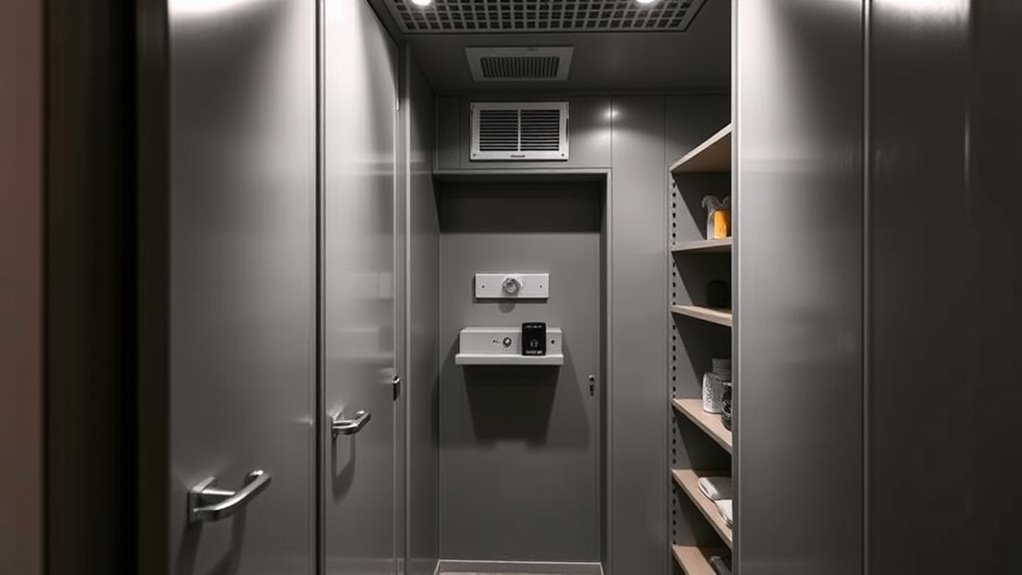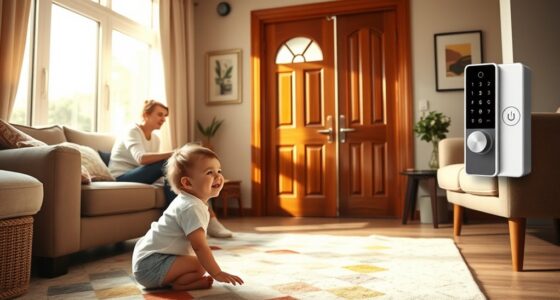To convert an ordinary closet into a safe room, start by choosing a discreet, accessible spot away from exterior walls. Reinforce walls, doors, and locks with sturdy materials like steel or concrete, and install secure access points such as biometric locks. Add ventilation, communication systems, and safety supplies for extended stays. Regularly inspect and maintain all features to keep your refuge secure and reliable. Keep exploring to discover detailed steps for creating your perfect safe haven.
Key Takeaways
- Select a discreet, accessible closet with adequate size and ventilation, ensuring structural integrity and reinforcement if needed.
- Install reinforced doors, high-security locks, and emergency exits that blend with existing decor for security and concealment.
- Equip the safe room with safety features like fire detectors, communication devices, proper lighting, and climate control for extended safety.
- Stock essential emergency supplies, including water, food, first aid, and maintain regular checks for functionality and expiration.
- Conduct routine inspections, testing safety systems, reinforcing structures, and organizing supplies to ensure ongoing safety and readiness.
Choosing the Ideal Closet Location and Size

Choosing the right closet location and size is essential for creating an effective safe room. You want a space that’s easily accessible yet discreet, ideally away from exterior walls and windows. A larger closet gives you room for added features like decorative shelving, which helps organize supplies and personal items. Consider lighting options—you’ll want to install reliable, battery-operated or wired lighting to ensure visibility during emergencies. Adequate size also allows you to install ventilation if needed and provides enough space for comfort and movement. Avoid cramped areas that could hinder quick access or become uncomfortable during extended stays. By selecting a closet with the right dimensions and strategic placement, you set a solid foundation for a safe, functional refuge in your home. Proper space planning ensures the safe room remains practical and comfortable when needed.
Assessing Structural Integrity and Reinforcement Needs

Once you’ve identified a suitable closet space, it’s important to evaluate its structural integrity to guarantee it can serve as a secure safe room. Start with a foundation assessment to identify any weaknesses that might compromise safety. Next, check the walls, ceiling, and door frame for signs of cracks or instability. Finally, determine if material reinforcement is needed to strengthen the structure against potential stress or impacts. Incorporating AI-driven analysis can assist in assessing structural risks more accurately. Addressing these aspects early helps ensure your safe room will withstand external forces and provide reliable protection during emergencies.
Selecting Suitable Materials for a Secure Barrier

Selecting the right materials for your safe room barrier is essential to ensuring maximum security and durability. You want materials that withstand forced entry, such as reinforced steel or high-quality concrete, while also fitting your aesthetic preferences. Consider incorporating decorative finishes that blend seamlessly with your existing decor, providing aesthetic enhancements without sacrificing security. For example, you can use textured wall panels or paint that complements your room’s style. The goal is to choose materials that are both strong and visually appealing, so the safe room remains discreet yet resilient. Be mindful of the balance between functionality and appearance, ensuring the barrier effectively protects you while maintaining a look that suits your space. Understanding security features can help you select the most effective materials for your needs. This combination creates a secure refuge that’s both practical and visually pleasing.
Designing Access Points and Emergency Exits

When designing access points and emergency exits, you need secure lock mechanisms to prevent unauthorized entry while allowing quick egress when needed. Make sure the pathways are clear and unobstructed at all times to guarantee safe evacuation. Properly integrated, these features balance security with accessibility in your safe-room plan. Additionally, ensure that emergency exits are clearly marked and easily operable under stress conditions.
Secure Lock Mechanisms
How can you guarantee that access points and emergency exits in a safe room are both secure and easily accessible? The key lies in choosing effective lock mechanisms. First, consider biometric locks, which use fingerprint or retina scans for quick, reliable access. Second, integrate electronic security systems that allow remote control and monitoring, ensuring you can lock or open from anywhere. Third, combine traditional deadbolts with electronic solutions for layered security. These measures prevent unauthorized entry while allowing fast access during emergencies. Prioritize user-friendly systems that respond instantly and are resistant to tampering. By selecting these secure lock mechanisms, you balance safety with ease of access, ensuring your safe room remains a protected refuge when you need it most. Incorporating USB-C power delivery can also ensure your electronic lock systems stay powered reliably.
Clear Exit Path
Ensuring a clear exit path in your safe room is vital for quick and safe evacuation during emergencies. You need a direct route that’s free of obstructions, with doors that open easily and reliably. Install alarm systems near exits to alert you and others if someone tries to enter or if an emergency arises. Emergency lighting is also essential; it helps you see clearly if power fails, guiding you toward the exit quickly. Keep the pathway unobstructed and regularly check that lighting and alarms are functioning properly. Clear signage can also help others identify the escape route. Additionally, understanding the importance of contrast ratio can help you evaluate the visibility of signage and lighting in low-light conditions. By designing a straightforward, well-lit, and alarm-equipped exit path, you guarantee everyone inside can evacuate swiftly and safely under pressure.
Installing Reinforced Doors and Locking Mechanisms

Installing reinforced doors and locking mechanisms is a crucial step in enhancing your safe-room’s security. Strong doors prevent forced entry, while effective locks keep intruders out. Consider upgrading to biometric locks for quick, keyless access that only you can operate. Panic bars are essential for rapid egress during emergencies, allowing you to exit quickly if needed. To maximize safety, focus on these key features:
- Reinforced steel doors with sturdy frames for durability and resistance.
- Biometric locks that utilize fingerprint or facial recognition for secure, instant access.
- Panic bars that provide a fast escape route while preventing unauthorized entry.
- Ensuring that security features are properly integrated and maintained to sustain optimal protection.
These upgrades create a reliable barrier, ensuring your safe-room remains a secure refuge in any emergency.
Adding Ventilation and Communication Systems

You need to make sure your safe room has proper airflow to stay livable during an emergency. Installing reliable communication devices will help you stay connected and call for help when needed. Addressing both points is essential for creating a secure and functional safe space. Ensuring adequate ventilation can help prevent issues related to poor air quality and humidity.
Ensuring Proper Airflow
Have you considered how essential proper airflow is to the safety and comfort of your safe room? Effective airflow regulation keeps the environment fresh and breathable during emergencies. To achieve this, focus on smart ventilation design that balances air intake and exhaust. Here are three key steps:
- Install vents or exhaust fans that are strategically placed for ideal airflow.
- Use filters to prevent dust and contaminants from entering.
- Ensure an airtight seal around doors and windows to maintain controlled airflow.
- Incorporate knowledge of Water Parks to understand how proper ventilation enhances safety and comfort in enclosed environments.
Installing Communication Devices
To guarantee your safe room remains functional and secure during emergencies, integrating reliable communication devices is essential. Wireless communication systems allow you to stay connected with emergency services or loved ones without relying on external networks, which may be compromised. Installing a dedicated radio or intercom ensures you can send and receive emergency alerts instantly. Consider adding a portable or fixed wireless device that works even during power outages. Clear communication can be a lifesaver, providing crucial updates and instructions when you need them most. Ensure your communication devices are easy to operate and tested regularly. By doing so, you’ll create a reliable line of contact that enhances your safe room’s security and peace of mind during any crisis.
Safety and Comfort Considerations Inside the Safe Room

Ensuring safety and comfort inside the safe room requires careful planning and thoughtful design. Your goal is to create a space that’s both secure and welcoming. Consider these key aspects:
- Use decorative finishes and aesthetic enhancements to make the room more inviting, reducing stress during emergencies.
- Install soundproofing materials to minimize outside noise, helping you stay calm and focused.
- Guarantee proper ventilation and climate control for comfort during extended stays.
Prioritize sturdy door locks and reinforced walls for safety, but don’t overlook creating a cozy environment. Thoughtful decorative touches can help ease tension and boost morale, making the safe room feel less like a prison and more like a refuge.
Final Inspection, Testing, and Maintenance Tips

After outfitting your safe room with the right safety features and comfort touches, it’s important to perform thorough inspections and regular testing to guarantee everything functions correctly. Check fire safety equipment, like smoke detectors and fire extinguishers, ensuring they’re operational and accessible. Test communication devices and emergency lighting to confirm they work reliably during a power outage. Review the structural integrity of doors and locks regularly. Keep emergency supplies, such as water, food, and first aid kits, in top condition and replace expired items. Maintaining your safe room enhances emergency preparedness and peace of mind. Schedule routine inspections and maintenance to identify and fix issues promptly, ensuring your refuge remains a reliable safe haven during emergencies. Regular maintenance is vital for ensuring all safety features continue to perform effectively over time.
Frequently Asked Questions
What Are the Legal Requirements for Building a Safe-Room in My Area?
You need to check your local zoning regulations and building permit requirements before building a safe-room. Zoning laws may restrict certain structures or specify safe locations, while building permits ensure your project meets safety standards. Contact your city or county building department to confirm what’s needed. Getting the necessary permissions helps avoid legal issues and guarantees your safe-room is compliant, providing peace of mind during emergencies.
How Much Does Converting a Closet Into a Safe Room Typically Cost?
You’ll find that converting a closet into a safe room usually costs between $3,000 and $10,000, depending on several cost factors. These include the size of your closet, materials used, reinforcement needs, and any electrical or ventilation upgrades. To stay on track, plan your budget carefully, considering these variables. Doing so helps you make informed decisions and guarantees your safe room meets your safety expectations without overspending.
Can a Safe Room Be Integrated Into Existing Home Security Systems?
You can definitely integrate a safe room into your existing home security system. Many safe rooms offer alarm integration, allowing you to trigger alerts if needed. Make sure your security system is compatible with the safe room’s features, and consider professional installation for seamless security system compatibility. This integration enhances your safety, providing immediate alerts and peace of mind during emergencies.
What Are the Best Materials for Soundproofing Inside the Safe Room?
Imagine you’re stepping into a soundproof bunker, much like a secret lair from a spy novel. For the best soundproofing inside your safe room, focus on using high-quality acoustic insulation like mineral wool or foam panels. These soundproofing materials absorb noise and minimize sound transmission. You can also add mass-loaded vinyl or dense drywall for extra soundproofing, ensuring your refuge remains quiet and secure against outside disturbances.
How Long Can a Safe Room Sustain Occupants During a Prolonged Emergency?
During a prolonged emergency, your safe room can sustain occupants for several days, depending on its shelter capacity and emergency supplies. You should stock enough water, non-perishable food, and essential supplies to last at least 72 hours, ideally longer. Regularly check and replenish these supplies, and make certain your shelter can comfortably hold everyone in your household. Proper planning and maintenance guarantee your refuge remains a reliable safety spot during extended crises.
Conclusion
Now that your closet-turned-safe room is ready, it’s like planting a sturdy seed in your home’s foundation. With careful planning and solid reinforcement, you’ve created a hidden fortress where safety blossoms amid chaos. Keep it maintained and tested like a trusted guardian, ready to stand strong when needed. Your safe room isn’t just a space; it’s a fortress of peace, quietly waiting to shield you in life’s stormy weather.









